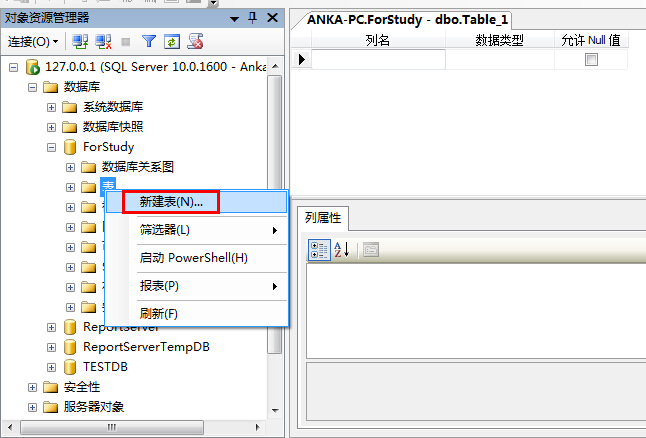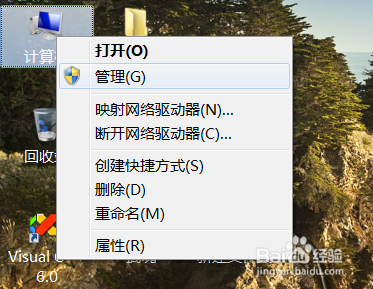SQLServer 2008数据库降级到2005低版本
由于目前还广泛使用着SQLServer2000,很多公司又想使用新的SQLServer,从而直接【分离/附加】或者【备份/还原】数据库,在不同版本之间存放。往往就会遇到版本不兼容的问题。前几天遇到了从我本机2008R2上备份的一个数据库还原到2008上面时报错:

从运行版本10.50.2500(2008R2是10.50)和10.00.1600(2008是10.00)中可以看出这个版本不兼容问题,大部分情况下,从低版本升级到高版本,只要不是跨度太大,如2000升级到2012,都不会怎么报错。除非使用了一些新版本不兼容的特性如*=来实现left join的语句。但是就像上图那样,从高版本还原到低版本的时候,问题就出现了,而且几乎一定会报错。
下面给出几个小建议,例子是从2008 降级到2005:
方法一:使用图形化操作(GUI),打开SSMS(SQL Server Management Studio)
步骤1:右键你要降级的数据库,按下图选择:

步骤2:在对话框中选择:

步骤3:在【高级】中选择下图:

步骤4:把脚本保存起来,然后在SQLServer2005中运行脚本。详细步骤可以看:http://bbs.csdn.net/topics/390438560?page=1#post-394316973 中的13楼的回复,有截图步骤5:通过【任务】→【导入数据】,把数据从2008导入到使用脚本创建的库上如下图,就完成了:

方法二:使用系统自带的存储过程实现:sp_dbcmptlevel ——将某些数据库行为设置为与指定的 SQL Server 版本兼容
下面是其内部实现代码:
SET QUOTED_IDENTIFIER ON
SET ANSI_NULLS ON
GO
create procedure sys.sp_dbcmptlevel -- 1997/04/15
@dbname sysname = NULL, -- database name to change
@new_cmptlevel tinyint = NULL OUTPUT -- the new compatibility level to change to
as
set nocount on
declare @exec_stmt nvarchar(max)
declare @returncode int
declare @comptlevel float(8)
declare @dbid int -- dbid of the database
declare @dbsid varbinary(85) -- id of the owner of the database
declare @orig_cmptlevel tinyint -- original compatibility level
declare @input_cmptlevel tinyint -- compatibility level passed in by user
,@cmptlvl80 tinyint -- compatibility to SQL Server Version 8.0
,@cmptlvl90 tinyint -- compatibility to SQL Server Version 9.0
,@cmptlvl100 tinyint -- compatibility to SQL Server Version 10.0
select @cmptlvl80 = 80,
@cmptlvl90 = 90,
@cmptlvl100 = 100
-- SP MUST BE CALLED AT ADHOC LEVEL --
if (@@nestlevel > 1)
begin
raiserror(15432,-1,-1,'sys.sp_dbcmptlevel')
return (1)
end
-- If no @dbname given, just list the valid compatibility level values.
if @dbname is null
begin
raiserror (15048, -1, -1, @cmptlvl80, @cmptlvl90, @cmptlvl100)
return (0)
end
-- Verify the database name and get info
select @dbid = dbid, @dbsid = sid ,@orig_cmptlevel = cmptlevel
from master.dbo.sysdatabases
where name = @dbname
-- If @dbname not found, say so and list the databases.
if @dbid is null
begin
raiserror(15010,-1,-1,@dbname)
print ' '
select name as 'Available databases:'
from master.dbo.sysdatabases
return (1)
end
-- Now save the input compatibility level and initialize the return clevel
-- to be the current clevel
select @input_cmptlevel = @new_cmptlevel
select @new_cmptlevel = @orig_cmptlevel
-- If no clevel was supplied, display and output current level.
if @input_cmptlevel is null
begin
raiserror(15054, -1, -1, @orig_cmptlevel)
return(0)
end
-- If invalid clevel given, print usage and return error code
-- 'usage: sp_dbcmptlevel [dbname [, compatibilitylevel]]'
if @input_cmptlevel not in (@cmptlvl80, @cmptlvl90, @cmptlvl100)
begin
raiserror(15416, -1, -1)
print ' '
raiserror (15048, -1, -1, @cmptlvl80, @cmptlvl90, @cmptlvl100)
return (1)
end
-- Only the SA or the dbo of @dbname can execute the update part
-- of this procedure sys.so check.
if (not (is_srvrolemember('sysadmin') = 1)) and suser_sid() <> @dbsid
-- ALSO ALLOW db_owner ONLY IF DB REQUESTED IS CURRENT DB
and (@dbid <> db_id() or is_member('db_owner') <> 1)
begin
raiserror(15418,-1,-1)
return (1)
end
-- If we're in a transaction, disallow this since it might make recovery impossible.
set implicit_transactions off
if @@trancount > 0
begin
raiserror(15002,-1,-1,'sys.sp_dbcmptlevel')
return (1)
end
set @exec_stmt = 'ALTER DATABASE ' + quotename(@dbname, '[') + ' SET COMPATIBILITY_LEVEL = ' + cast(@input_cmptlevel as nvarchar(128))
-- Note: database @dbname may not exist anymore
exec(@exec_stmt)
select @new_cmptlevel = @input_cmptlevel
return (0) -- sp_dbcmptlevel
GO
语法
sp_dbcmptlevel [ [ @dbname = ] name ] [ , [ @new_cmptlevel = ] version ]
参数
[ @dbname = ] name
要为其更改兼容级别的数据库的名称。数据库名称必须符合标识符的规则。name 的数据类型为 sysname,默认值为 NULL。
[ @new_cmptlevel = ] version
数据库要与之兼容的 SQL Server 的版本。version 的数据类型为 tinyint,默认值为 NULL。该值必须为下列值之一:
80 = SQL Server 2000
90 = SQL Server 2005
100 = SQL Server 2008
返回代码值
0(成功)或 1(失败)
注意事项:
后续版本的 Microsoft SQL Server 将删除该功能。请不要在新的开发工作中使用该功能,并尽快修改当前还在使用该功能的应用程序。 改为使用 ALTER DATABASE 兼容级别。
关于备份,可以看我的另外一篇文章。
以上就是本文的全部内容,希望对大家的学习有所帮助,也希望大家多多支持潘少俊衡。
版权声明
本文仅代表作者观点,不代表本站立场。
本文系作者授权发表,未经许可,不得转载。
本文地址:/shujuku/MsSQL/97551.html













